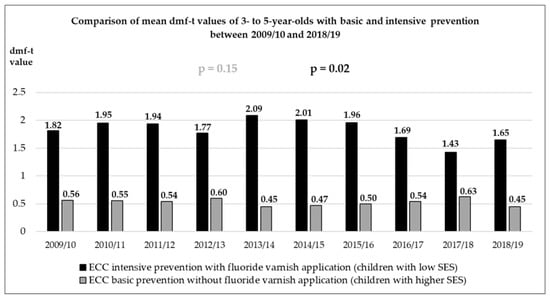Abstract
Dental caries constitutes a public health challenge. As preventive strategies are desirable, this retrospective cohort study aimed to assess the caries experience and increment in children attending kindergartens with an early childhood caries (ECC) preventive program (intervention group, IG) compared to basic prophylaxis measures (control group, CG) located in areas of different socioeconomic status (SES) within Marburg (Germany). The long-term caries experience (2009–2019) of these 3–5-year-old kindergarten children was evaluated. For the caries increment, dental records of 2019 were screened for the availability of a minimum of two dental examinations at least 8 months apart. Caries was scored according to the WHO criteria (dmf–t). The data were split by observation period (300–550 and >550 days). Overall, 135 children (Ø 3.7 years) attended IG, and 132 children (Ø 3.6 years) attended CG. After 300–550 days, no significant differences were found between both groups regarding mean caries increment and experience (p > 0.05). After >550 days, IG with low SES exhibited a high caries experience. Fluoride varnish applications could not reduce the caries increment compared to CG in the short-term but slightly decreased the long-term caries experience. Comprehensive ECC prevention measures actively involving parents are needed to overcome the caries burden. View Full-Text
Keywords: early childhood caries; caries experience; caries increment; preventive program; fluoride varnish
Figure 1
Excerpt:
5. Perspectives and Conclusions
- The children with low SES and fluoride varnish application showed positive long-term effects regarding the reduction in caries. However, the decline in caries cannot be explained by the fluoride varnish application alone, as it may have been influenced by confounding factors that were not collected in the study. By implementing the intensive preventive program, the staff of the dental public health service expected a greater decline in caries. Despite the fact that fluoride varnish applications were not capable of preventing carious lesion formation over a short-term period, it would certainly be a valuable add-on to other long-term preventive programs that provide early and low-threshold information [82] and motivation for parents to adopt tooth-healthy dietary and dental hygiene behaviors [83]. Against this background, the well-implemented fluoride varnish application for kindergarten children from socially underprivileged areas should be maintained and supplemented by another interdisciplinary prevention concept involving gynecologists, social workers, pediatricians, and dentists.
- After the implementation of further ECC prevention elements, the complete concept should be evaluated prospectively with appropriate parent questionnaires to survey home nutrition and dental care behavior, dental visits, sociodemographic data, etc.
- The interdisciplinary prevention concept described under point one and used in the Dormagen study [45] should be utilized for all children in the region. For the evaluation of the program, it is important that the respective intervention and the control group do not show any differences during the first dental examination regarding age distribution, mean caries experience, the proportion of children with naturally healthy dentition, and SES.
- Since the likelihood of the reduction in caries is greatest where a large caries experience is found, future studies should include children attending kindergartens in social hotspots. A kindergarten group, used as a historical comparison, could serve as a control group [45]. The children of the control group should not take part in the interdisciplinary program. Better still would be a comparison with a control group from another region without a preventive program and based on matched pairs [47] in terms of age, SES, and caries experience at the first dental examination.
- For such a prospective study, it would already be a success if kindergarten children with a low SES were at the same level of caries increment as kindergarten children with a higher SES. In the present population, this would mean a 0.3 dmf–t lower increase in caries for an observation period of about 550 days. Under these conditions, a sample size calculation was carried out and showed that a group sample size of 450 (intervention group) and 450 (control group) achieved a 90% power to detect a difference of 0.3 using a one-sided Mann–Whitney U when the significance level (alpha) of the test is 0.05, and the standard deviation is 1.5 in both groups.
*Full-text study online at https://www.mdpi.com/2077-0383/11/10/2864/htm

